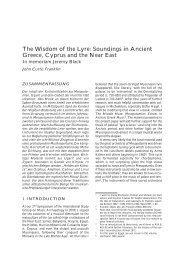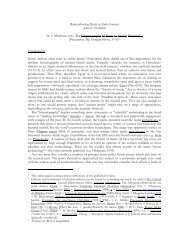KINYRAS AT PYLOS John C. Franklin University of Vermont Kinyras ...
KINYRAS AT PYLOS John C. Franklin University of Vermont Kinyras ...
KINYRAS AT PYLOS John C. Franklin University of Vermont Kinyras ...
You also want an ePaper? Increase the reach of your titles
YUMPU automatically turns print PDFs into web optimized ePapers that Google loves.
ecent tablet from Thebes is not against the hypothesis, since different instrument names could<br />
have been variously current in the Minoan-Mycenaean world, some <strong>of</strong> which need not have<br />
survived into the Iron Age. 28 Indeed it is quite remarkable to find that lyra was already known in<br />
LBA Thebes; it previously seemed a novelty <strong>of</strong> the Archaic period, being absent from Homer,<br />
who uses two completely different terms, phorminx and kitharis! 29 And there is a semantic gap,<br />
for Mycenaean lyra was surely not restricted to the simple tortoiseshell instrument—its common<br />
Classical usage, already in the Homeric Hymn to Hermes—but normally suggested more<br />
imposing models like the one depicted in the Throne Room frescos at Pylos. Doubtless generic<br />
considerations play a role here, evidence that the epic and ‘lyric’ traditions <strong>of</strong> early Greece were<br />
quite distinct. This has important implications when considering possible survivals <strong>of</strong><br />
Mycenaean palatial music, the most important theatre for which was surely cult hymns—e.g. the<br />
sort purveyed at Sparta and Delphi by the illustrious citharodes <strong>of</strong> seventh-century Lesbos<br />
(Terpander et al., the so-called Lesbian genos). 30 If the knr was itself ever current in Mycenaean<br />
Greece—as distinct from priests or other individuals bearing the title or name ‘<strong>Kinyras</strong>’—it<br />
certainly did not survive the palaces, not being attested again until the Septuagint, and then only<br />
in Hebraic contexts.<br />
<strong>Kinyras</strong> the Mariner<br />
A second <strong>Kinyras</strong> has been hypothesized among the Pylos tablets, in a list <strong>of</strong> twelve<br />
‘shipbuilders’ (na-u-do-mo). 31 That these men are recorded by name shows their relative social<br />
prominence: they were no mere laborers but specialists, naval architects and shipwrights <strong>of</strong><br />
28 As was true <strong>of</strong> later Greece (lyra vs. Homeric phorminx). The new tablet is TH Av 106.7, presupposing<br />
the form *lurastÆw against the later luristÆw, itself only slightly attested (Plin. Ep. 9.17.3; Artem. 4.72).<br />
See Aravantinos 1996; Younger 1998, 18 n. 42; Aravantinos/Godart/Sacconi 2001, 29 f., 176–8;<br />
Aravantinos/Godart/Sacconi 2002, 82 f.<br />
29 Lyra in Archaic poetry: [Hom.] Marg. fr. 1.3 (West); Archil. frr. 54.11, 93a.5 (West); Alcm. 140 PMGF:<br />
kerkolyra; Sapph. frr. 44.33, 103.9, 208 (Voigt); Alc. fr. 307c (Voigt); Stesich. 278.2 PMGF.<br />
30 See further <strong>Franklin</strong> 2006, 39–42, 52–63.<br />
31 PY Vn 865: Bennett 1955, 03, 195; Landau 1958, 89.






